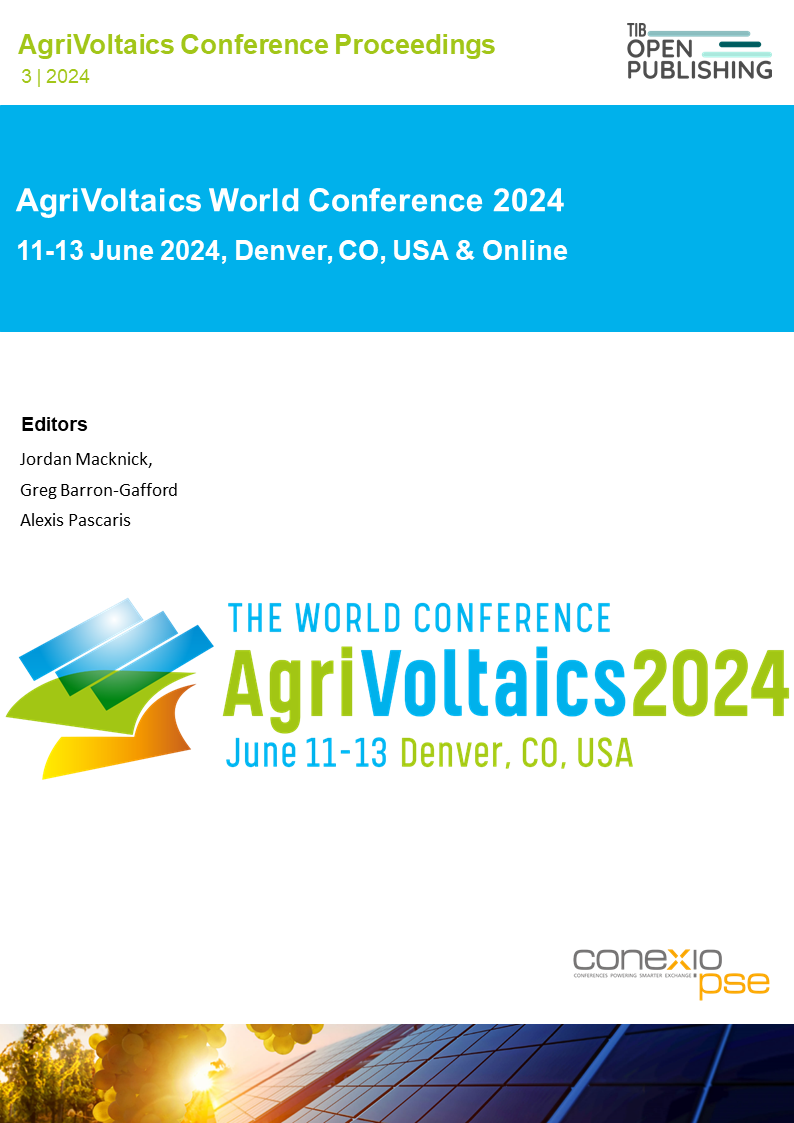Integral Design of an Agrivoltaics Research System in Northern Minas Gerais, Brazil
DOI:
https://doi.org/10.52825/agripv.v3i.1400Keywords:
Agrivoltaics, Conceptual Design, Shading SimulationAbstract
This study aims to derive conceptual agrivoltaic (AV) designs for the first AV research pilot in Minas Gerais Brazil by applying a Key Performance Indicator (KPI) based evaluation method. A selected AV design is assessed regarding its shading characteristics in various scenarios using raytracing algorithms in Python based on the Solstice software. The proposed Elevated AV system demonstrates the best performance respecting the project specific objectives. For the respective design we vary row distances in three scenarios, enabling regression analysis to relate the annual average shading rate to the row pitch. The analysis reveals that for a 30% shading rate, a 3.2 m row distance is required, which is finally recommended to respect the rather sun-loving crop types. Through a border effect analysis, we conclude the necessity of implementing a total AV pilot area of approximately 700 m² to conduct agricultural experiments on 300 m² without edge effects. In general, we highlight the importance of precise AV system design for optimizing agricultural and photovoltaic (PV) performance.
Downloads
References
Instituto Brasileiro de Geografia e Estatística. (2022). Demographic Census.
Montenegro, S., Ragab, R., Gaiser, T., de Araújo, J. C., & Pappenberger, F. (2012). Impact of possible climate and land use changes in the semi-arid regions. Journal of Hydrology, 434-435, 55-68. https://doi.org/10.1016/j.jhydrol.2012.02.036
ABSOLAR. (2024, May 21). Infográfico - ABSOLAR. Retrieved from https://www.absolar.org.br/mercado/infografico/
Barron-Gafford, G. A., Pavao-Zuckerman, M. A., Minor, R. L., Sutter, L. F., Barnett-Moreno, I., Blackett, D. T., Thompson, M., Dimond, K., Gerlak, A. K., Nabhan, G. P., & Macknick, J. E. (2019). Agrivoltaics provide mutual benefits across the food–energy–water nexus in drylands. Nature Sustainability, 2(9), 848-855. https://doi.org/10.1038/s41893-019-0364-5
Fraunhofer Chile Research. (2023, September 4). Proyecto Agro PV en Minas Gerais, Brasil. Retrieved from https://www.fraunhofer.cl/es/Prensa/news/cset-notices/Proyecto_Agro_PV_en_Minas_Gerais_Brasil.html
Instituto Nacional de Meteorologia (INMET). (n.d.). BDMEP. Retrieved from https://bdmep.inmet.gov.br/
Beuth Verlag. (2024). DIN SPEC 91434 - 2021-05. Retrieved from https://www.dinmedia.de/en/technical-rule/din-spec-91434/337886742
Holmgren, W. F., Hansen, C. W., & Mikofski, M. A. (2018). pvlib python: a python package for modeling solar energy systems. Journal of Open Source Software, 3(29), 884. https://doi.org/10.21105/joss.00884
Souka, A. F., & Safwat, H. H. (1966). Determination of the optimum orientations for the double exposure flat-plate collector and its reflections. Solar Energy, 10, 170-174.
Faiman, D. (2008). Assessing the outdoor operating temperature of photovoltaic modules. Progress in Photovoltaics: Research and Applications, 16(4), 307-315. https://doi.org/10.1002/pip.813
Dobos, A. P. (2014). PVWatts Version 5 Manual.
Méso-Star. (2020). Solstice. Retrieved from https://www.meso-star.com/projects/solstice/solstice.html
Perez, R., Ineichen, P., Maxwell, E. L., Seals, R. D., & Zelenka, A. (1992). Dynamic global-to-direct irradiance conversion models. ASHRAE Transactions, 98, 354-369.
Duffie, J. A., & Beckman, W. A. (2013). Solar Engineering of Thermal Processes (2nd ed.). Madison, New York; John Wiley & Sons, Hoboken. https://doi.org/10.1002/9781118671603
Published
How to Cite
Conference Proceedings Volume
Section
License
Copyright (c) 2025 Frederik Schönberger, Ana Valentina Puentes, David Jung, Polyanna Mara de Oliveira

This work is licensed under a Creative Commons Attribution 4.0 International License.
Accepted 2025-01-23
Published 2025-03-27
